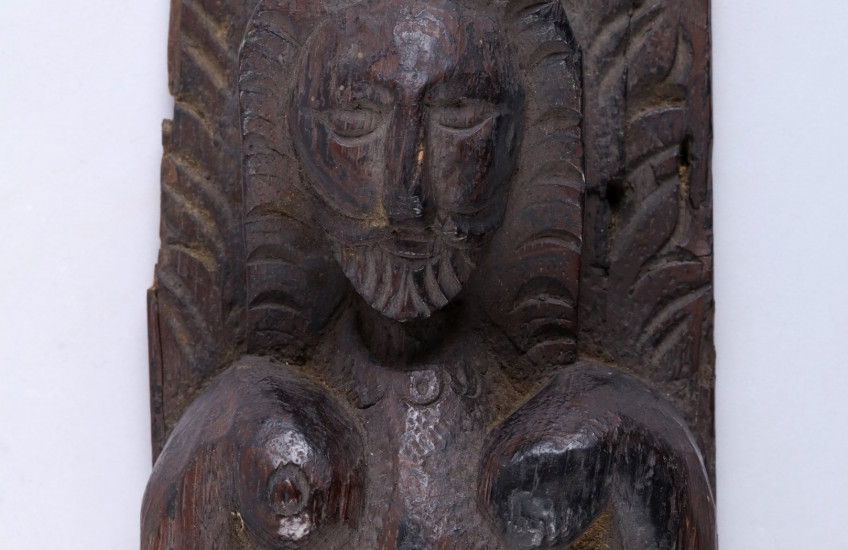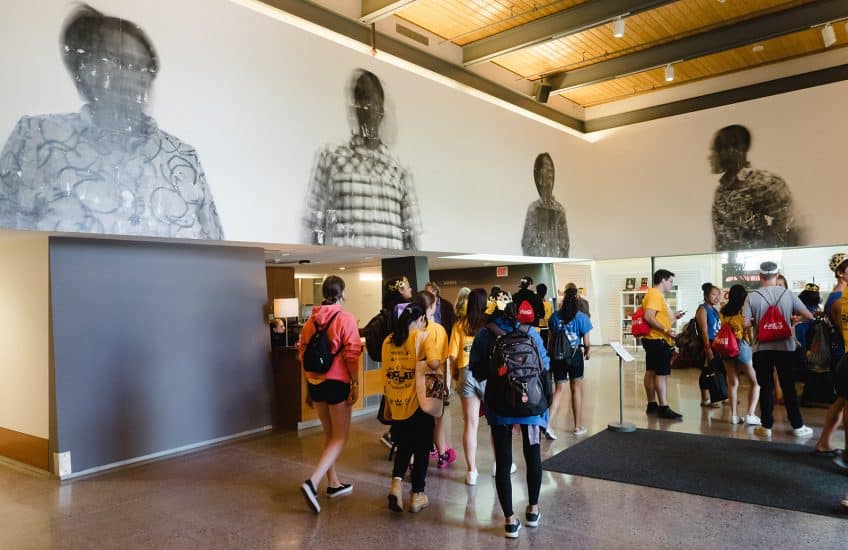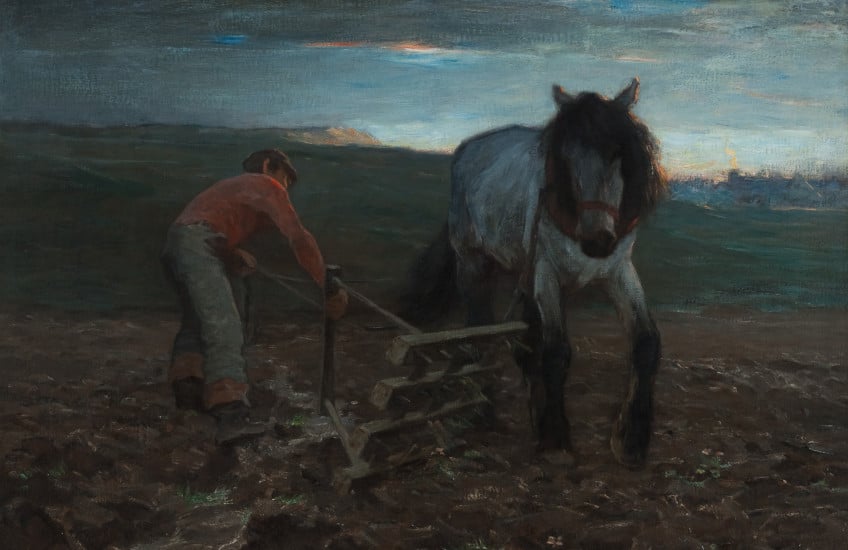

>> Hi, there. My name is Sunny Kerr. I’m curator of contemporary art at the Agnes Etherington Art Centre. And we are here in the Agnes Atrium to talk about a new installation by Canadian artist, Sandra Brewster, called Blur. And Blur is, first and foremost, a bold statement regarding black Canadians, black Kingstonians, almost as if it’s saying, “We are here.” Really asserting a kind of presence of black people in our communities. And this is important because we live in a climate that can be sympathetic to a kind of postracialist idea, a post-racialism idea wherein it’s almost as if normative cultures, white centred mainstream cultures, are saying racism is historical. We’re not racist. But at the same time, one often hears broad assumptions or one makes oneself broad assumptions like, you know, Kingston is so white — Canada is so white, which enacts a certain kind of erasure of racialized peoples and black Canadians, particularly. And so with this work, especially through her material choices, Sandra Brewster is making this kind of strong assertion at the same time that it’s — it has many layers of complexity. So at the same time that it’s making this bold assertion, it is also doing it in a complex way that, I think, eschews the politics of tokenism, and makes more complex the, kind of, demand for multicultural representation. And I think, through her material choices, Sandra Brewster is also — one of the keys to the work is that certain things are always kept hidden. So essentially, the work is images of three black community members from Kingston. One of them, of course, appears twice. There are four figures, as you can see here. Brewster is depicting them here in blurred motion. And in — and that’s the way in which she really gets at a kind of transitional state at the same time as there’s this, kind of, sticking to or presence, there’s also a sense of movement and transition within. Really influenced, I think, by Sandra Brewster’s own heritage. Her — the legacy of her own parents’ migration to Canada from Guyana in the 1960s. And it’s through precisely the — the material process, which is a gel transfer process. Ink is printed right onto the walls in a quite unpredictable and labour intensive process. And — and through this they come to look almost like old, worn photographs because of the kind of tearing, creasing, and folding that happens during the gel transfer process. I should say, finally, that the installation was also designed as a commission for the collection, whereby Sandra Brewster visited Kingston and, through an open call, photographed members of Kingston’s black community and made these new works, one of which will be entering the Agnes collection and then can be remounted at — at this scale in the future.

>> How did Turning the Harrow – Early Morning arrive at Agnes and at Queen’s University? This painting has an unusual story in and provenance. Alicia Boutilier, Chief Curator and Curator of Canadian Historical Art at the Agnes Etherington Art Centre discusses the adventurous tale of how the painting was once held at the Metropolitan Museum of Art in New York City and ultimately found its home in the Agnes collection of Canadian Historical Art.
>> Horatio Walker’s Turning the Harrow – Early Morning, has had a winding path of institutional ownership, indicative of changing fashions in art. The Ontario born artist made a very successful living through painting. Horatio Walker was talented, but also trend savvy. When the artist chose rural Quebec as the sustained subject for his art, he was joining a popular movement in American painting. As my curatorial predecessor, Dorothy Farr, has pointed out, it was the Barbizon style that sent Walker to Quebec and not Quebec that inspired a Barbizon style. By the late 1800s, when Walker was painting Turning the Harrow, he divided his time between summers on Île d’Orléans, just east of Quebec City, and winters in New York, where he had an art dealer on Fifth Avenue. He was an elected member of the Society of American Artists, and an associate, later full member of the Royal Canadian Academy of Arts. You could say he held dual artistic citizenship, but his market was really in the U.S. Wealthy Americans who had been collecting European art to represent a cosmopolitan view began to pay serious attention to art produced at home. Significant among those collectors was New York merchant George Arnold Hearn. Hearn was hailed as a contributor to the cause of contemporary American art. And as part of that cause, in the 1910s, he donated two Horatio Walkers, including Turning the Harrow, to the Metropolitan Museum of Art, where he served as a trustee. Turning the Harrow hung for years in the museum. Walker having been fully adopted as an American artist. Then in 1956, the painting was deaccessioned and sold and kind of disappeared from the record. Though the Metropolitan Museum of Art kept its other Walker from Hearn, also of a harrower, American art and Canadian art, for that matter, had moved on to champion other movements by the mid-20th century. Around the same time, the Corcoran Gallery of Art in Washington also deaccessioned their Walker painting, entitled Ave Maria, which is now in the Art Gallery of Hamilton Collection. In 1977, the Agnes Etherington Art Centre mounted a comprehensive exhibition on Walker, with a publication by Dorothy Farr. As part of a professed series of reappraisals of Canadian artists who were important and successful in their own time, but who had fallen out of fashion. There was renewed interest in Walker’s work, as the story of Canadian art was being assembled and historicized in the post-centennial years. At the time of the exhibition, the location of Turning the Harrow was not known. But the ground was set so that when it emerged at auction again in 1994 it was purchased for the collection here. How to look at Horatio Walker today. A privileged artist, claimed, erased, revived, questioned, in two colonial countries, asserting nationhoods. There are so many critical issues raised through such idealization of labour, but I’m still arrested by the painting. It tells me something about enterprises imposed on the world, but also something about colour. The arrest lies not in the high-keyed tones of impressionism or the hot hues of post-impressionism, movements that superseded Walker’s popularity, but in the low light of dawn. The way the horse’s ears and mane are limbed from behind by the same light that catches the farmer’s right shoulder. The silvering of the land before warming up on a chilly morning, Walker really nails it. I retreat temporarily to his use of paint in depicting this scene.